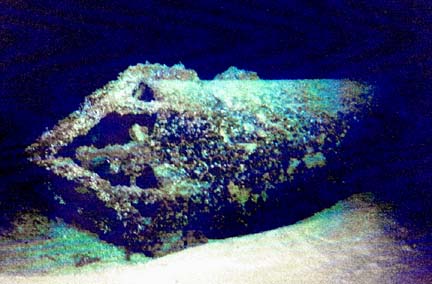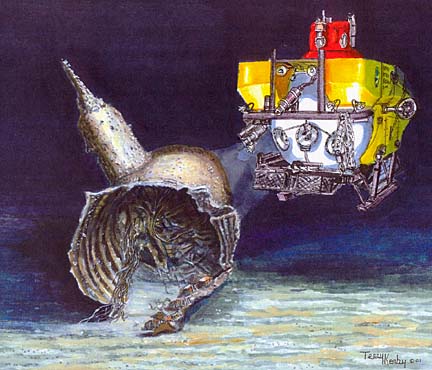


Oahu dive turns A SEARCH of the sea floor off Oahu this week has turned up another piece of the Pearl Harbor puzzle: the bow of a Japanese "midget" submarine.
up WWII Japanese
midget submarine
A university team succeeds
where the "Titanic discoverer"
previously had failedJapan's 'midget' subs
harried Pearl forcesBy Burl Burlingame
bburlingame@starbulletin.comThe torpedo tubes are empty, and there is evidence that the section was deliberately dumped at sea, said University of Hawaii Pisces submarine pilot Terry Kerby. "There's a hole punched into it where a hawser was attached to drag it."
An Imperial Navy midget submarine was involved in battle with an American destroyer an hour before the Pearl Harbor attack and sank a mile or so off the harbor entrance. This first casualty of America's entry into World War II has never been discovered, despite two searches by National Geographic and numerous dives by the University of Hawaii's Undersea Research Lab.
A search last year by "Titanic discoverer" Robert Ballard of the Woods Hole Oceanographic Institute also came up empty-handed. Kerby noted that Ballard swept the same part of the ocean the university team did this week. "I guess Ballard wasn't looking very closely."
Hawaii Undersea Research Lab and Woods Hole in Massachusetts are the two primary oceanographic research centers in the United States. The Hawaii lab's primary mission is investigating the biology and geology of the ocean floor.

The bow section completes a midget submarine that was likely brought to Hawaii from Okinawa after the war and scuttled after it was examined. Near the bow is an aft section with the tail and motor that were discovered by Hawaii Undersea Research Lab in 1992, and a center section with the sail and periscope found by the university team last summer. The pieces are at a depth of 1,200 feet.The three pieces would create a complete submarine if reattached. They are separated at the joints where such submarines are bolted together, and the center section shows evidence of an internal explosion, such as those created by scuttling charges placed aboard these submarines by the Imperial Navy.
The net cutter on the bow section discovered this week, however, matches the type used by midget submarines that attacked Pearl Harbor. Later models used different designs.
The waters outside Pearl Harbor were, for a long time, a dumping ground for the military. The university team prefers the Pearl Harbor channel dump sites for training submarine crews precisely because of the hazards and surprises down there.
Midget submarines captured off Okinawa were almost identical to the Pearl Harbor midgets, said James Delgado, director of the Vancouver Maritime Museum, who keeps a file on missing Japanese submarines.
"There has always been speculation that these craft were brought to Hawaii, with other war booty, for study and then jettisoned," said Delgado. "It's a tantalizing reminder that the first vessel lost in the great Pacific War remains to be found.
"That Ballard passed right over this piece and didn't see it suggests how difficult the search is. It's like trying to find a nickel on the sidewalk from 20 stories up in the middle of the night, in a driving rain."
FOR AMERICA the first shots of World War II were fired in a patch of deep, blue ocean just southeast of the entrance to Pearl Harbor. Japan’s ‘midget’ subs
harried Pearl forcesA Navy admiral was able to sink
one of the infiltrators before the
onslaught of aircraftBy Burl Burlingame
bburlingame@starbulletin.comIn the early morning hours of Dec. 7, 1941, an hour prior to the imperial Japanese air assault on the U.S. fleet, the destroyer USS Ward, a Navy patrol aircraft and a top-secret Japanese submarine tangled in a brief battle.
The underwater element of the Japanese attack on Pearl Harbor has been largely overlooked. The Imperial Navy's effort to ring Oahu with a fleet of submarines and pick off American warships included five test-model "midget" submarines, 80 feet long and capable of 20-knot bursts of speed underwater. But at Pearl Harbor the subs were asked to stealthily enter the harbor and lie quietly.
Each carried two crew members and two torpedoes. They were carried close to the harbor entrance on the backs of larger submarines and cut loose on the night of Dec. 6.
At dawn on Dec. 7, a midget submarine was observed attempting to follow the cargo ship Antares past the anti-torpedo nets that closed off the harbor entrance.
Adm. Husband Kimmel, who predicted that hostilities between Japan and the United States would begin with submarine attacks, had drilled his crew relentlessly on the skills of anti-submarine warfare. A Navy PBY patrol bomber and the Ward -- the destroyer assigned that day to patrol the harbor entrance -- immediately bore down on the tiny periscope.
The PBY dropped smoke pots to mark the location, and the forward gun of the Ward fired once at the submarine and missed. As it swept by the target, the gun on the starboard side of the ship fired another round, knocking a hole in the submarine's conning tower. Ward then rolled four depth charges off its stern, and the explosions lifted the craft out of the water.
Less than an hour later, Japanese aircraft attacked Pearl Harbor. In addition to the five midget submarines, the Japanese employed 27 full-size oceangoing submarines. These lurked in Hawaiian waters for another month, shooting up the neighbor islands and sinking shipping vessels.
The midget submarine sunk by Ward has never been discovered. Of the other four, one disappeared completely -- and recent photographic evidence suggests this midget submarine fired torpedoes at Battleship Row -- one was rammed and sunk inside Pearl Harbor, one was captured at Waimanalo, and another was discovered in shallow water near Keehi Lagoon in 1960. The bow section of this last submarine was unbolted and dumped at sea with the live torpedoes still aboard.